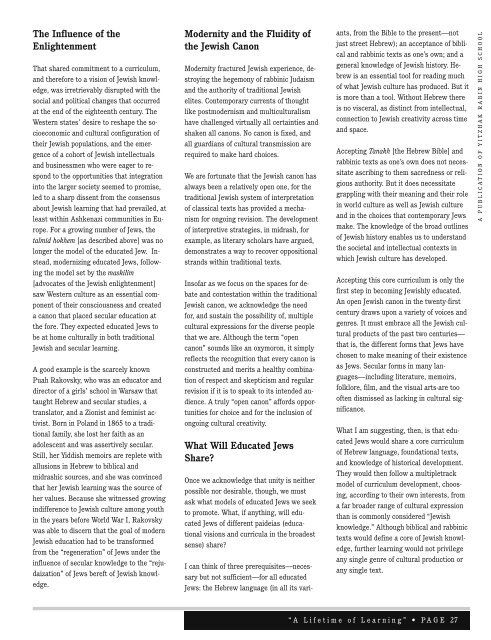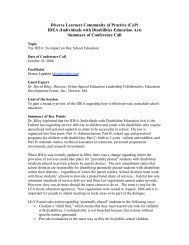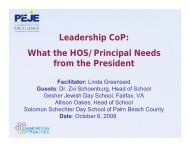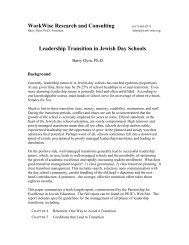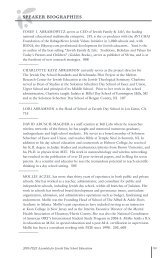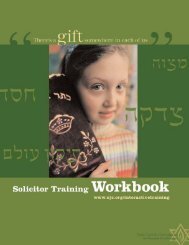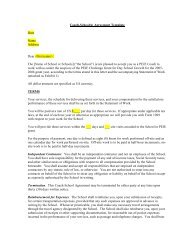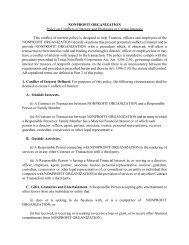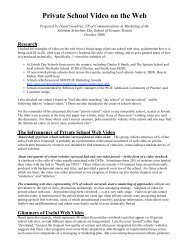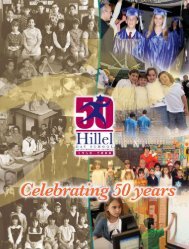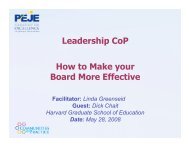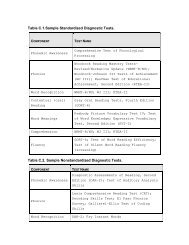âA Lifetim e of Learningâ - Partnership for Excellence in Jewish ...
âA Lifetim e of Learningâ - Partnership for Excellence in Jewish ...
âA Lifetim e of Learningâ - Partnership for Excellence in Jewish ...
You also want an ePaper? Increase the reach of your titles
YUMPU automatically turns print PDFs into web optimized ePapers that Google loves.
The Influence <strong>of</strong> theEnlightenmentThat shared commitment to a curriculum,and there<strong>for</strong>e to a vision <strong>of</strong> <strong>Jewish</strong> knowledge,was irretrievably disrupted with thesocial and political changes that occurredat the end <strong>of</strong> the eighteenth century. TheWestern states’ desire to reshape the socioeconomicand cultural configuration <strong>of</strong>their <strong>Jewish</strong> populations, and the emergence<strong>of</strong> a cohort <strong>of</strong> <strong>Jewish</strong> <strong>in</strong>tellectualsand bus<strong>in</strong>essmen who were eager to respondto the opportunities that <strong>in</strong>tegration<strong>in</strong>to the larger society seemed to promise,led to a sharp dissent from the consensusabout <strong>Jewish</strong> learn<strong>in</strong>g that had prevailed, atleast with<strong>in</strong> Ashkenazi communities <strong>in</strong> Europe.For a grow<strong>in</strong>g number <strong>of</strong> Jews, thetalmid hokhem [as described above] was nolonger the model <strong>of</strong> the educated Jew. Instead,moderniz<strong>in</strong>g educated Jews, follow<strong>in</strong>gthe model set by the maskilim[advocates <strong>of</strong> the <strong>Jewish</strong> enlightenment]saw Western culture as an essential component<strong>of</strong> their consciousness and createda canon that placed secular education atthe <strong>for</strong>e. They expected educated Jews tobe at home culturally <strong>in</strong> both traditional<strong>Jewish</strong> and secular learn<strong>in</strong>g.A good example is the scarcely knownPuah Rakovsky, who was an educator anddirector <strong>of</strong> a girls’ school <strong>in</strong> Warsaw thattaught Hebrew and secular studies, atranslator, and a Zionist and fem<strong>in</strong>ist activist.Born <strong>in</strong> Poland <strong>in</strong> 1865 to a traditionalfamily, she lost her faith as anadolescent and was assertively secular.Still, her Yiddish memoirs are replete withallusions <strong>in</strong> Hebrew to biblical andmidrashic sources, and she was conv<strong>in</strong>cedthat her <strong>Jewish</strong> learn<strong>in</strong>g was the source <strong>of</strong>her values. Because she witnessed grow<strong>in</strong>g<strong>in</strong>difference to <strong>Jewish</strong> culture among youth<strong>in</strong> the years be<strong>for</strong>e World War I, Rakovskywas able to discern that the goal <strong>of</strong> modern<strong>Jewish</strong> education had to be trans<strong>for</strong>medfrom the “regeneration” <strong>of</strong> Jews under the<strong>in</strong>fluence <strong>of</strong> secular knowledge to the “rejudaization”<strong>of</strong> Jews bereft <strong>of</strong> <strong>Jewish</strong> knowledge.Modernity and the Fluidity <strong>of</strong>the <strong>Jewish</strong> CanonModernity fractured <strong>Jewish</strong> experience, destroy<strong>in</strong>gthe hegemony <strong>of</strong> rabb<strong>in</strong>ic Judaismand the authority <strong>of</strong> traditional <strong>Jewish</strong>elites. Contemporary currents <strong>of</strong> thoughtlike postmodernism and multiculturalismhave challenged virtually all certa<strong>in</strong>ties andshaken all canons. No canon is fixed, andall guardians <strong>of</strong> cultural transmission arerequired to make hard choices.We are <strong>for</strong>tunate that the <strong>Jewish</strong> canon hasalways been a relatively open one, <strong>for</strong> thetraditional <strong>Jewish</strong> system <strong>of</strong> <strong>in</strong>terpretation<strong>of</strong> classical texts has provided a mechanism<strong>for</strong> ongo<strong>in</strong>g revision. The development<strong>of</strong> <strong>in</strong>terpretive strategies, <strong>in</strong> midrash, <strong>for</strong>example, as literary scholars have argued,demonstrates a way to recover oppositionalstrands with<strong>in</strong> traditional texts.Ins<strong>of</strong>ar as we focus on the spaces <strong>for</strong> debateand contestation with<strong>in</strong> the traditional<strong>Jewish</strong> canon, we acknowledge the need<strong>for</strong>, and susta<strong>in</strong> the possibility <strong>of</strong>, multiplecultural expressions <strong>for</strong> the diverse peoplethat we are. Although the term “opencanon” sounds like an oxymoron, it simplyreflects the recognition that every canon isconstructed and merits a healthy comb<strong>in</strong>ation<strong>of</strong> respect and skepticism and regularrevision if it is to speak to its <strong>in</strong>tended audience.A truly “open canon” af<strong>for</strong>ds opportunities<strong>for</strong> choice and <strong>for</strong> the <strong>in</strong>clusion <strong>of</strong>ongo<strong>in</strong>g cultural creativity.What Will Educated JewsShare?Once we acknowledge that unity is neitherpossible nor desirable, though, we mustask what models <strong>of</strong> educated Jews we seekto promote. What, if anyth<strong>in</strong>g, will educatedJews <strong>of</strong> different paideias (educationalvisions and curricula <strong>in</strong> the broadestsense) share?I can th<strong>in</strong>k <strong>of</strong> three prerequisites—necessarybut not sufficient—<strong>for</strong> all educatedJews: the Hebrew language (<strong>in</strong> all its variants,from the Bible to the present—notjust street Hebrew); an acceptance <strong>of</strong> biblicaland rabb<strong>in</strong>ic texts as one’s own; and ageneral knowledge <strong>of</strong> <strong>Jewish</strong> history. Hebrewis an essential tool <strong>for</strong> read<strong>in</strong>g much<strong>of</strong> what <strong>Jewish</strong> culture has produced. But itis more than a tool. Without Hebrew thereis no visceral, as dist<strong>in</strong>ct from <strong>in</strong>tellectual,connection to <strong>Jewish</strong> creativity across timeand space.Accept<strong>in</strong>g Tanakh [the Hebrew Bible] andrabb<strong>in</strong>ic texts as one’s own does not necessitateascrib<strong>in</strong>g to them sacredness or religiousauthority. But it does necessitategrappl<strong>in</strong>g with their mean<strong>in</strong>g and their role<strong>in</strong> world culture as well as <strong>Jewish</strong> cultureand <strong>in</strong> the choices that contemporary Jewsmake. The knowledge <strong>of</strong> the broad outl<strong>in</strong>es<strong>of</strong> <strong>Jewish</strong> history enables us to understandthe societal and <strong>in</strong>tellectual contexts <strong>in</strong>which <strong>Jewish</strong> culture has developed.Accept<strong>in</strong>g this core curriculum is only thefirst step <strong>in</strong> becom<strong>in</strong>g <strong>Jewish</strong>ly educated.An open <strong>Jewish</strong> canon <strong>in</strong> the twenty-firstcentury draws upon a variety <strong>of</strong> voices andgenres. It must embrace all the <strong>Jewish</strong> culturalproducts <strong>of</strong> the past two centuries—that is, the different <strong>for</strong>ms that Jews havechosen to make mean<strong>in</strong>g <strong>of</strong> their existenceas Jews. Secular <strong>for</strong>ms <strong>in</strong> many languages—<strong>in</strong>clud<strong>in</strong>gliterature, memoirs,folklore, film, and the visual arts-are too<strong>of</strong>ten dismissed as lack<strong>in</strong>g <strong>in</strong> cultural significance.What I am suggest<strong>in</strong>g, then, is that educatedJews would share a core curriculum<strong>of</strong> Hebrew language, foundational texts,and knowledge <strong>of</strong> historical development.They would then follow a multipletrackmodel <strong>of</strong> curriculum development, choos<strong>in</strong>g,accord<strong>in</strong>g to their own <strong>in</strong>terests, froma far broader range <strong>of</strong> cultural expressionthan is commonly considered “<strong>Jewish</strong>knowledge.” Although biblical and rabb<strong>in</strong>ictexts would def<strong>in</strong>e a core <strong>of</strong> <strong>Jewish</strong> knowledge,further learn<strong>in</strong>g would not privilegeany s<strong>in</strong>gle genre <strong>of</strong> cultural production orany s<strong>in</strong>gle text.A P U B L I C A T I O N O F Y I T Z H A K R A B I N H I G H S C H O O L“ A L i f e t i m e o f L e a r n i n g ” • P A G E 27


